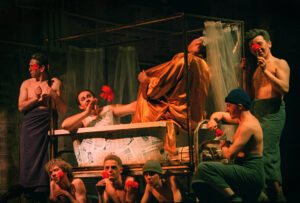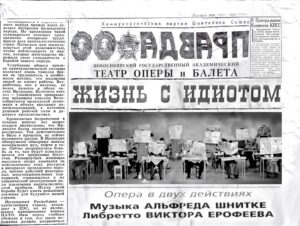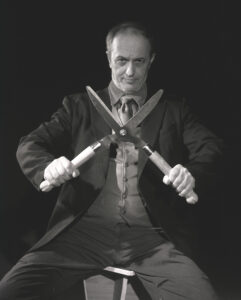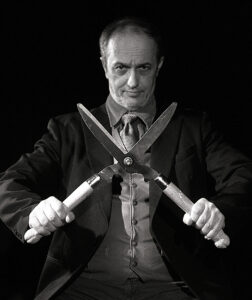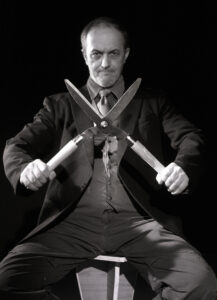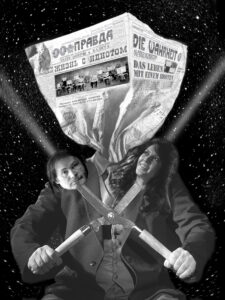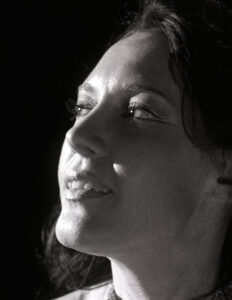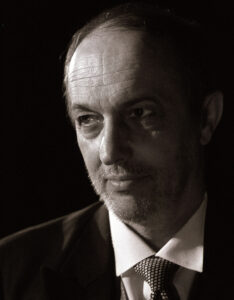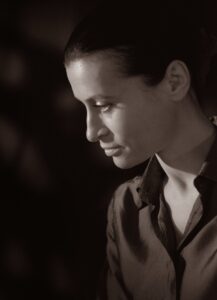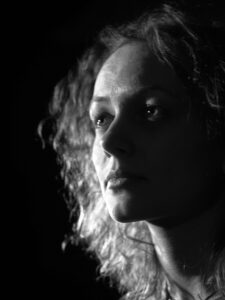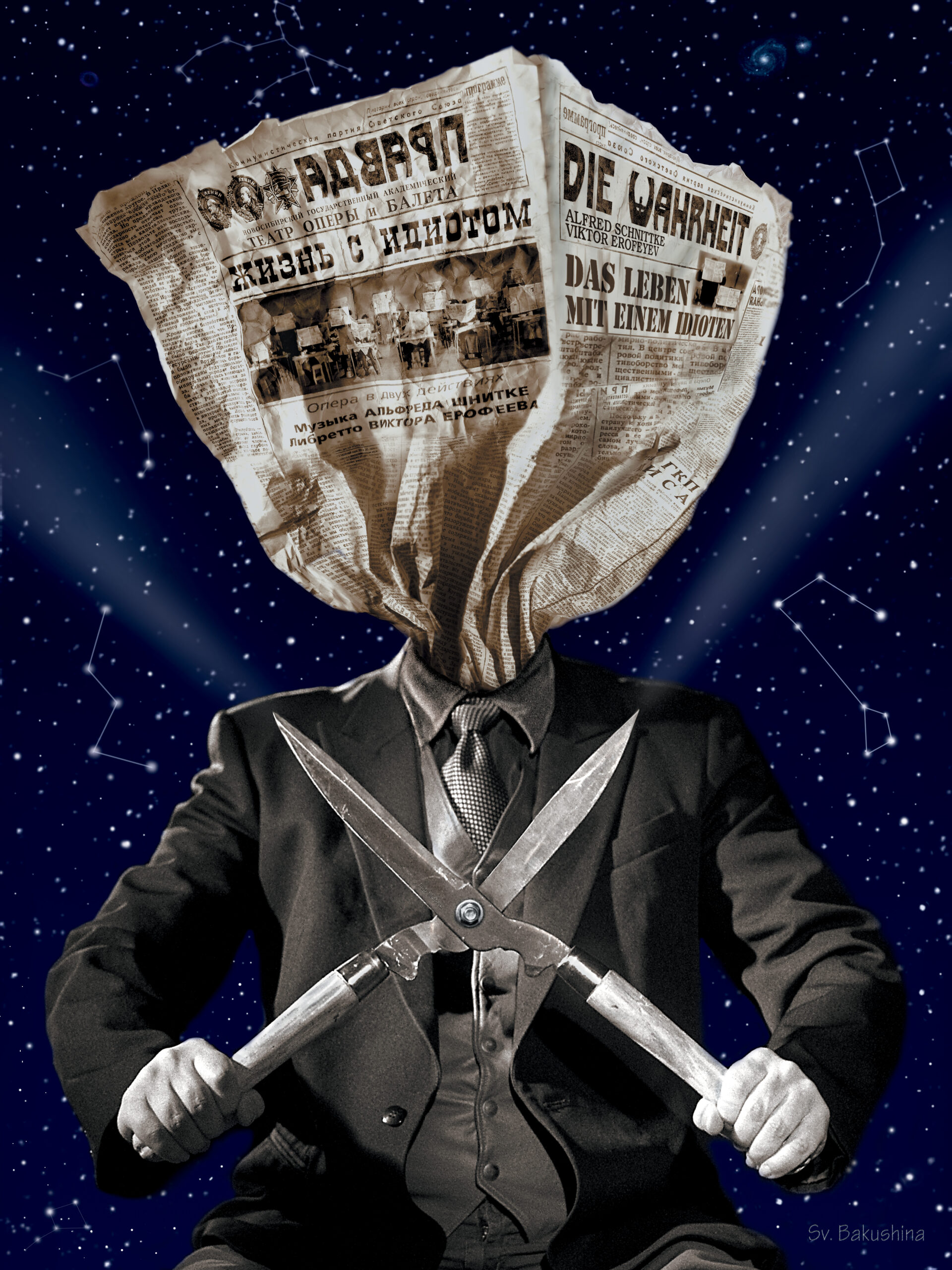Prologue
It was a cold, rainy Siberian day in 2003. I had just returned home from university — tired, soaked, and ready to collapse — when my mother told me that someone had called about a theatre project and would be phoning again soon. And indeed, they did. It was Olga Sidorova, who would later become a very close friend of mine.
Apparently, they had been visiting local galleries in search of an artist to design a poster for an opera. One particular illustration caught their eye: my drawing based on Bulgakov’s Master and Margarita, showing a young naked girl proudly flying a broomstick over a Siberian city. That was one of my first pieces to earn international recognition.
The opera in question was Life with an Idiot, and Olga was the assistant to Henryk Baranowski, a renowned Polish theatre director.
ACT I
Life with an Idiot
The Novosibirsk State Academic Opera and Ballet Theatre
Co-Production with Hahn Produktion, Germany
Music by Alfred Schnittke
Libretto by Victor Erofeyev
Directed by Henryk Baranowski
Music Director and Conductor Evgeny Volinsky
Poster and production photography: Svetlana Bakushina
2004
The First Photoshop and the Pink Clay Surprise
I had just gotten my first computer — a machine with 32 MB of RAM and a 4 GB hard drive. I promptly installed a copy of Photoshop that I had “acquired” from a Torrent site (strictly for educational purposes, of course). Armed with this fantastic setup, I embarked on my very first Photoshop adventure.
The very next day, I arrived at the theatre for a meeting. Olga led me through the building to a hotel-like area, and the first person I saw was a man holding two large pink penises and a utility knife. Enter Professor and Doctor Giga Lapiashvili, who had been invited to join the production as the set constructor.
The Language of Theatre (and Invented Russian)
Soon after, Henryk appeared — always smiling — and greeted me with a handshake. His Russian was impeccable, almost too perfect, with no discernible accent. The only clue betraying his foreignness was a peculiar vocabulary: words that didn’t exist in Russian but somehow made complete sense.
Strangely enough, these assertive, made-up phrases carried such clear meaning that the entire cast began using them. His “art nouveau” Russian quickly became a kind of in-house dialect at the theatre. Sometimes, his phrasing would unintentionally sound hilarious — even when he was being completely serious.
I remember one moment during rehearsal when he spoke into the microphone and loudly asked if he could “possess” the lead actors that evening (meaning, of course, whether they’d be attending the rehearsal). “Yes? And will I possess the chorus as well? Yes? Good!” In Russian, the word he used indeed sounded like a sexual innuendo.
The actors, a little confused but ever respectful, would always respond sincerely. Everyone loved him — it was impossible not to.
From Toilets to Metaphysics: Designing the Poster
Back to the story: Giga washed his hands and showed me a draft of the poster he’d created — a collage featuring a toilet with a hand sticking out of it. No one was particularly pleased with the design, so they decided to scrap the idea. The new concept was a man holding secateurs and a newspaper — but it needed to feel “metaphysical.”
The newspaper played a central role in the play’s visual identity. It wasn’t just a prop — it covered the walls of the set instead of wallpaper. Specifically, it was Pravda, the famous Soviet-Russian newspaper, which translates to “The Truth.”
The secateurs represented the main character, and because the play featured a fair amount of sexual content — including same-sex scenes — Henryk suggested a bold design twist. He asked Giga to attach two penises to the handles of the secateurs, so anyone holding them would literally be gripping them.
When I first arrived, Giga was in the middle of sculpting them out of clay. He showed us his progress and, with utmost seriousness, asked if the color and shape looked right. We all burst out laughing, each offering our opinion on the matter.
FIRST TURNING POINT
Siberian Crusaders Without a Cause
Novosibirsk, while known as a major cultural hub of Siberia, also carries a peculiar burden: an overabundance of fervent Christian activism. To put it bluntly — too many people with too much time on their hands. A group known as the “Orthodox activists” made it their mission to bombard city authorities with complaints and demands to cancel anything they deemed “inappropriate.” This included rock concerts, opera productions, and films they didn’t like.
Their influence led to the cancellation of performances by Marilyn Manson, Cannibal Corpse, the Polish metal band Behemoth, and the British group Cradle of Filth. In 2015, they went as far as protesting Wagner’s Tannhäuser, staged at the Novosibirsk Opera Theatre by director Timofey Kulyabin. The production was pulled from the repertoire, and the theatre’s director, Boris Mezdrich, was fired and replaced.
A similar situation surrounded Life with an Idiot, which faced substantial censorship. Welcome back to the Soviet Union, some would say. Yet, in spite of everything, the production went on to win Russia’s most prestigious national theatre award — the Golden Mask — for Best Opera, Best Set Design, and Best Male Opera Role.
The poster I created for Life with an Idiot also received recognition, earning a Gold Medal at an international photo salon in Macau. My university professors were so impressed they awarded me a full year of tuition-free study, and the Russian Professional Union of Photo Artists accepted me as a member.
Henryk Posing for a Poster
We arranged a photo shoot at the television studio where I worked at the time. Fortunately, I had access to professional studio equipment whenever I needed it for personal projects. Olga and Henryk arrived punctually, bringing the now-iconic secateurs discreetly wrapped in a plastic bag, along with a few shirt options.
The studio was already prepared: lights on, camera set. Henryk took a seat and I snapped the first shot. “I’m not ready,” he said. Then he straightened his posture, tensed all his muscles, and I could practically feel the surge of focused energy radiating from him. I took another shot — and it was perfect. We also took a few more “safer” versions where he concealed the handles of the secateurs… just in case.
Then came the more daring ideas: Henryk envisioned one blade featuring the head of composer Alfred Schnittke and the other a woman’s face mid-orgasm. There was a strikingly beautiful woman working in the theatre’s ticket office — black curls, expressive eyes, always adorned with bold makeup. Henryk, captivated by her presence, persuaded her to pose. I created a draft, but the concept didn’t quite land.
Instead, we went with a more abstract direction — radiant “energy rays” streaming from each blade, placing the entire scene in a cosmic setting. The final poster featured text in two languages: Russian on the left side with the opera title and theatre information, and German on the right.
INT – TYPICAL RUSSIAN RESTAURANT – NIGHT
That day, Olga, Henryk, and I went to a typical Russian restaurant, where he could experience the full power of Russian hospitality. We wanted him to try some traditional dishes and ordered draniki—grated and fried potato pancakes.
The young waitress accepted the order but returned a minute later to say they didn’t have draniki. We then asked for simple fried potatoes in a pan. She smiled, accepted the request, but came back again saying they didn’t have fried potatoes either. The only thing they could offer was unpeeled boiled potatoes… in half an hour.
At this point, Olga began a slow, deliberate conversation with the waitress:
OLGA
So you have potatoes, correct?
WAITRESS
Yes.
OLGA
Then go and tell the chef to get his ass off the sofa, grate and fry a couple of potatoes. Now.
Well, that worked. Too bad many things in Russia only work that way.
Technically, my little job was done and I was heading home. But what I didn’t know was that for the next ten years, Henryk would become one of my closest friends—and my family’s. He would be my mentor, my son’s godfather, and we would go on to collaborate on many more projects.
The very next day, Henryk called and privately hired me for a photo session with Joanna Vos, who played the “Wife” in the opera, as well as himself. And of course, I took a few pictures of Olga, too.
He later hired me again to do all the production photography. I was happy to take on the job, though I had to keep a low profile to avoid being seen by a friend of mine, Evgeniy Ivanov. He had worked for years as the resident photographer at the theatre, and it was technically his job to shoot all the productions. I really didn’t want him to know I was kind of stealing it.
by Svetlana Bakushina
Premiere night video
“Life With An Idiot” – Premiere in Novosibirsk, Russia, on February 10, 2004
Directed by Henryk Baranowski
co-produced by Novosibirsk State Academic Opera and Ballet Theatre and
Hahn Produktion.
Music: Alfred Schnittke
Libretto: Victor Erofeyev
Director: Henryk Baranowski
Music Director & Conductor: Evgeny Volinsky
Set Design: David Borovsky
Costumes: Nina Lepilina
Prop Design & Technical Direction: Gyorgy Lapiashvili
Chorus Master: Vyacheslav Podelsky
Lighting Design: Damir Ismagilov
Choreography: Sergei Grizai
Dramaturgy: Henrik Bien
Production Photography & Poster: Svetlana Bakushina
Alternating Cast:
I: Andrei Isakov, Alexander Lebedev
Wife: Joanna Woś, Olga Kolobova
Vova: Yuri Komov, Farit Khusainov
Guard: Konstantin Buinov, Ivan Potritsaev
Marcel Proust (both nights): Sergei Zakharov
Dancers: Oleg Bikovsky, Vyacheslav Vakhitov
❦ Winner of a Golden Mask Award
❦ Nominated for a Golden Mask Award
REHEARSALS
Golden Mask Awards
Winner
Best Opera Production
Nominations
Best Director (Henryk Baranowski)
Best Conductor (Evgeny Volynsky)
Best Set Design (David Borovsky)
Best Costume Design (Nina Lepilina)
Best Lighting Design (Damir Ismagilov)
Best Male Role (Andrei Isakov)
Best Female Role (Joanna Woś)
I also invite you to check out a wonderful blog post by my dear friend Kit Baker about this production. Click here to read and explore the insights!







